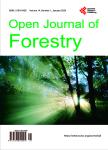Damaging Agents and Tree’s Health Condition in an Urban Forest
Damaging Agents and Tree’s Health Condition in an Urban Forest作者机构:Postgrado en Fitosanidad-Fitopatología Colegio de Postgraduados Campus Montecillo Texcoco Estado de México Postgrado en Ciencias Forestales Colegio de Postgraduados Campus Montecillo Texcoco Estado de México Consultor Independiente Colegio de Postgraduados Campus Montecillo Texcoco Estado de México
出 版 物:《Open Journal of Forestry》 (林学期刊(英文))
年 卷 期:2021年第11卷第3期
页 面:238-253页
学科分类:08[工学] 0812[工学-计算机科学与技术(可授工学、理学学位)]
主 题:Damaging Agents Urban Trees Bleeding Cankers Galls Health Categories Damage Severity Index
摘 要:Urban trees are subjected to different damaging agents throughout their lifetime. The aims of this study were to identify tree damaging agents, and to obtain a Damage Severity Index (DSI) in order to categorize tree health condition at San Juan de Aragon Park. Each tree was identified at species level in 28 randomly established plots in ten sections of the study area. Up to two types of damage were recorded per tree, based on the FIA (Forest Inventory an Analysis Program) protocol, and a DSI was obtained for each damaged tree considering location of damage, nature of the damaging agent and severity. A total of 753 trees were assessed and 12 species and 27 damaging agents were identified. Cankers, galls, the pepper tree psyllid and the red gum lerp psyllid were the most frequent damaging agents. Australian pine, red gum, Mediterranean cypress, Mexican white cedar, and California pepper were the most affected species. The DSI ranged from 3 to 17 and the average was 7.9. Sections J and H and the species California pepper, Australian pine, and Mexican white cedar presented the highest DSI. The tree population had a moderate health condition, while the aforementioned sections and tree species showed the poorest.



